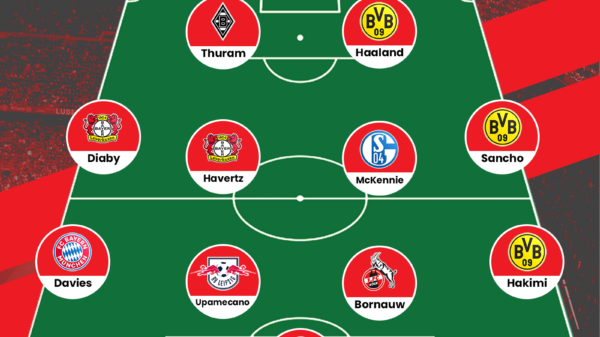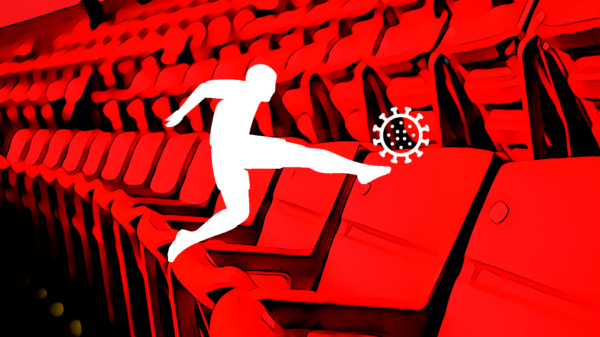Rishad Bharucha writes a detailed tactical analysis about the Bundesliga match that ended Schalke 0-1 Lverkusen.
November brought mixed fortunes for Roger Schmidt’s side, as Bayer Leverkusen looked more convincing in Europe than they did in domestic competitions. Leverkusen rely on a relatively narrow possession game most of the time to supply the likes of Chicharito and Kiessling. Prior to this away fixture against Schalke, a run of home games saw them concede goals to Bayern Munich and RB Leipzig and Schmidt will have hoped for a more solid defensive showing to back up his side’s possession statistics and secure a result.
Schalke come into this fixture on the back of two consecutive defeats away from home, having won their last four games at home in all competitions. With injuries to the likes of Huntelaar and Di Santo, they were looking to the likes of Choupo-Moting and Konoplyanka to provide some much needed inspiration in front of goal. Looking at the top ten teams in the table, Schalke might feel they deserve to be higher up in the pack, and this game against Bayer Leverkusen was a good opportunity to prove that.
Schalke were off to the worst possible start when Naldo was sent off after less than five minutes for pulling Chicharito down at the edge of the box as he was through on goal. This turned the game into a one-sided affair that still provided some intrigue, as Bayer Leverkusen clearly dominated in terms of possession, but Schalke clearly had the better chances in front of goal on the counter attack. The winning goal for Bayer Leverkusen came from a set piece, which must have been frustrating for the home side after defending for most of the game with ten men.
Line Ups
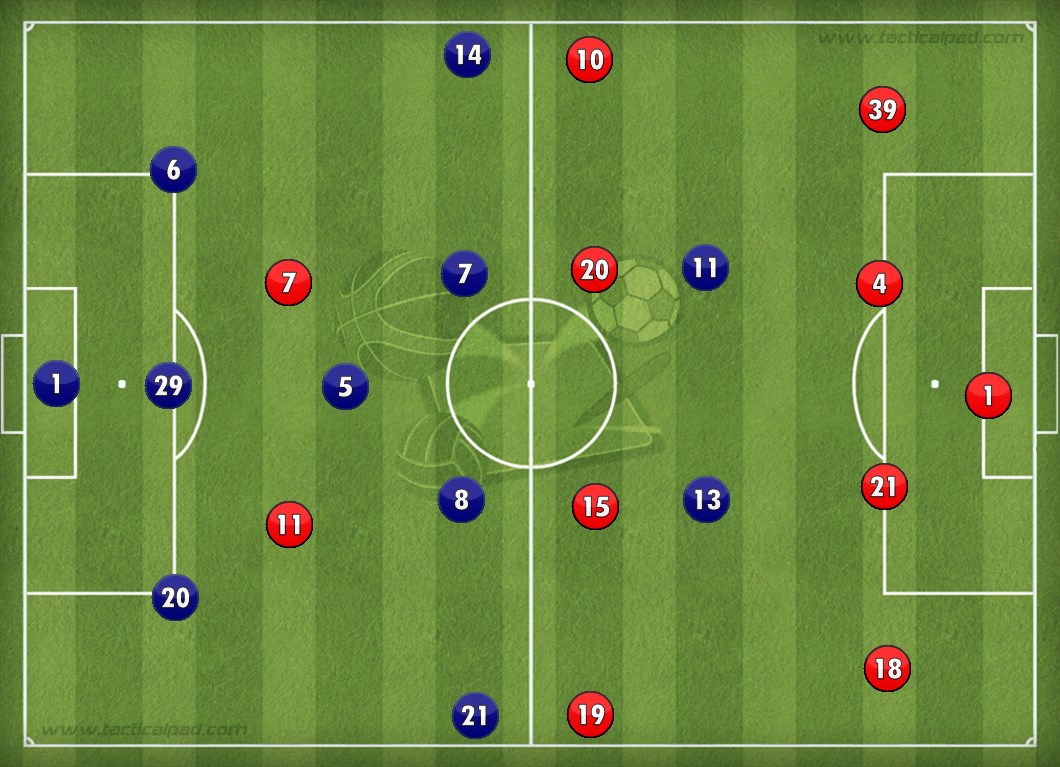
Made using TacticalPad
Schalke 04: Fährmann – Kehrer, Naldo, Kolasinac – Geis – Schöpf, Goretzka, Meyer, Baba – Choupo-Moting, Konoplyanka
Bayer Leverkusen: Leno – Henrichs, Tah, Toprak, Wendell – Aranguiz, Baumgartlinger – Brandt, Calhanoglu – Chicharito, Kießling
Leverkusen in possession
Bayer Leverkusen maintained good overall possession of the ball for longer periods than Schalke, but they were unable to penetrate the Schalke defense for large periods of the game. A common pattern in their play was the use of the wall pass where the receiving player would have his back to goal and play the ball back to the first player almost immediately. When used in the right space at the right moment, it can create more space between the lines or behind the opponents, enough for a penetrative run to be made that suddenly speeds up the play.
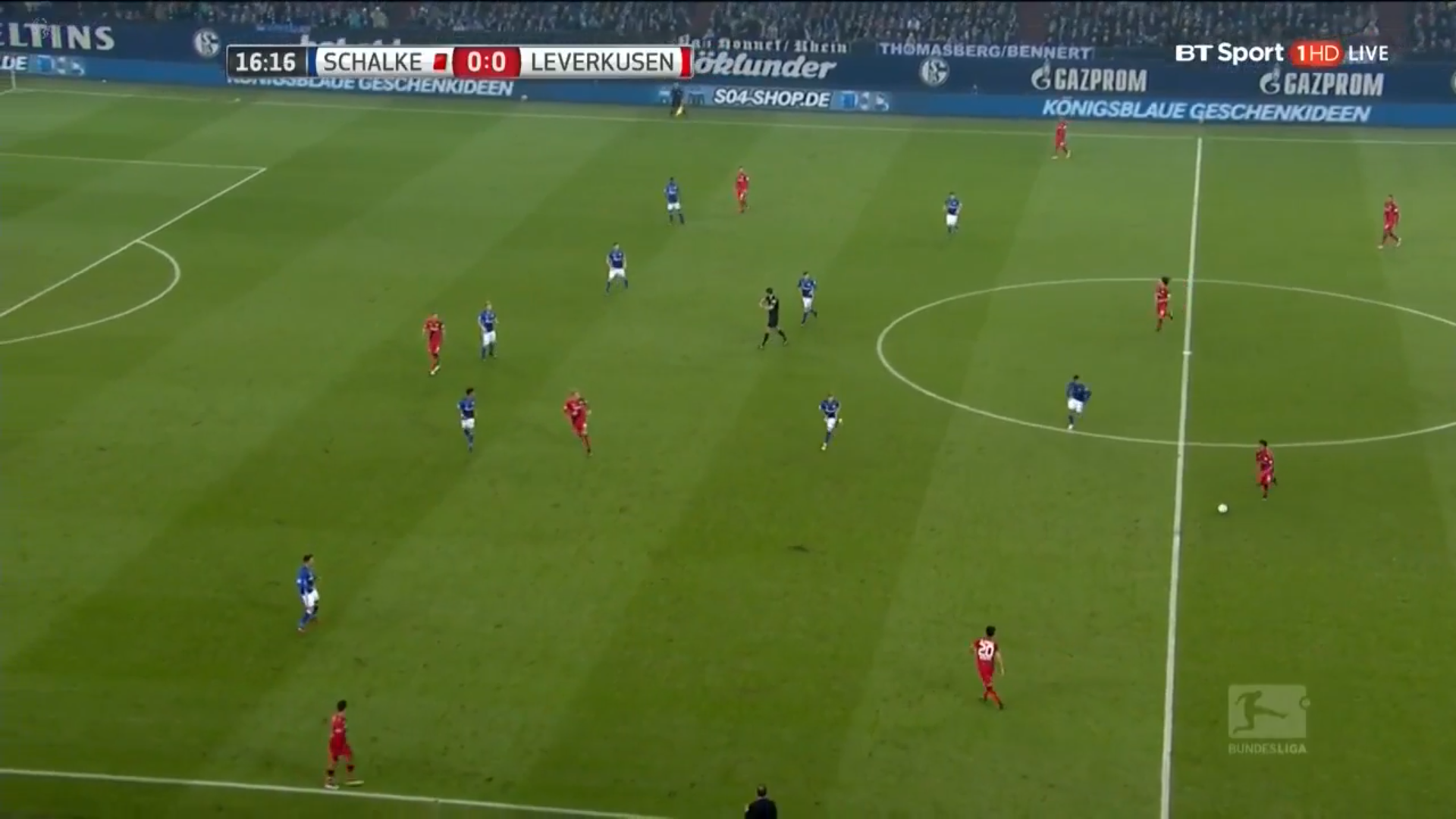
However, they seemed to rely on wall passes too much and often times the Schalke midfielders did not have to leave their space or get drawn into pressing the Leverkusen players. There were few runs behind the defense and the movement of the two strikers Chicharito and Kiessling, was not as dynamic as it should have been to exploit the potentially tired legs of a side with ten men. Central midfielder Julian Baumgartlinger was effective with his distribution and was often unchallenged in possession as he drifted into the attacking half of the field. In terms of providing the final ball, however, Leverkusen lacked the impetus in central midfield to split a tight Schalke defense.
Leverkusen on the wings
Leverkusen primarily used the wings to attempt to stretch the Schalke defense, but they were not quick, effective and were too predictable with their passage of play out wide. Wendell and Brandt were constantly trying to get behind the Schalke defense but the run behind the defense was almost always halted by the quick reactions of Schöpf and Kehrer teaming up against them. While Wendell did occasionally take a more direct route towards goal, he lacked that extra yard of pace to beat his man.
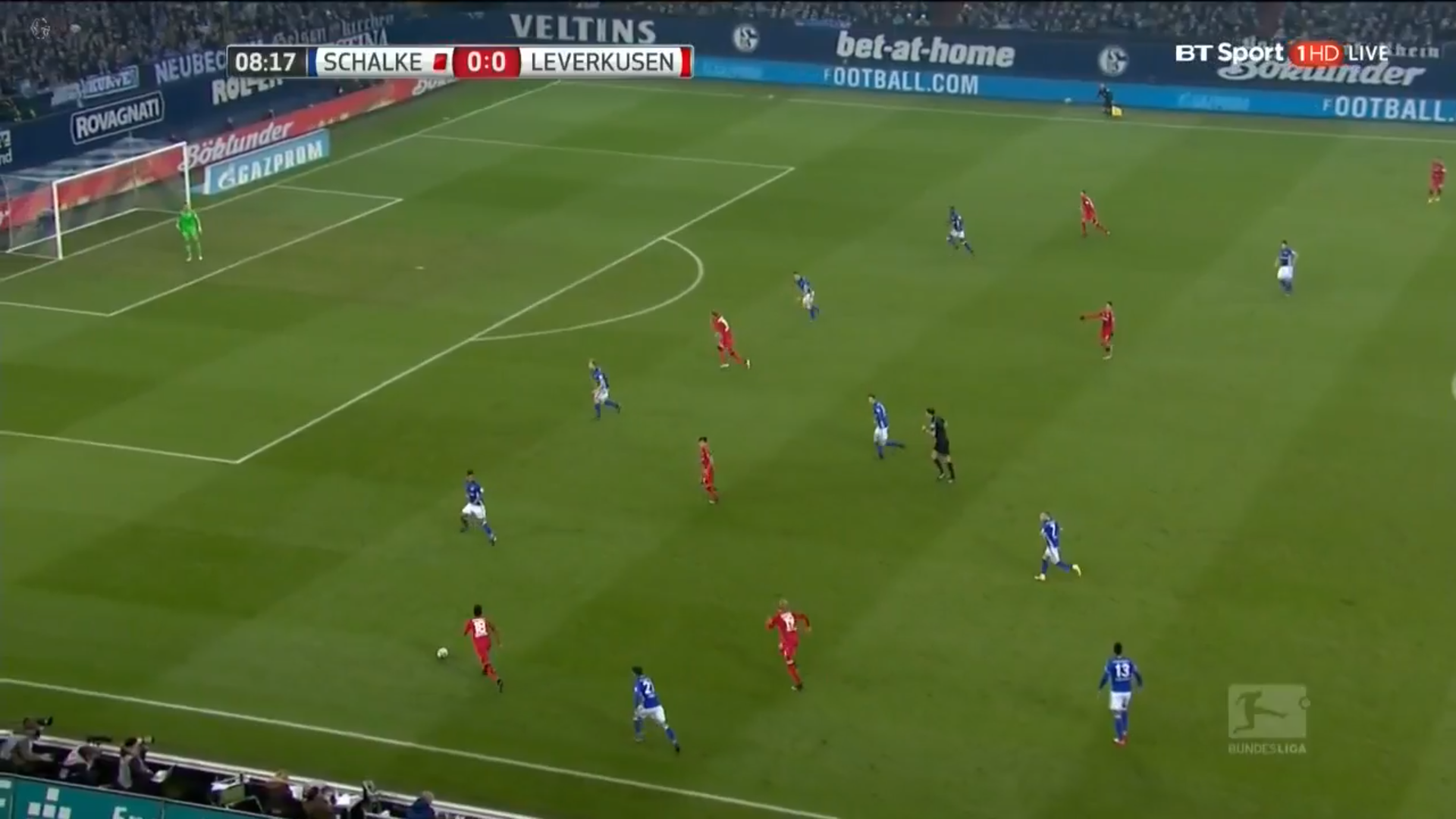
Chicharito drifted to the right a few times to create space and cross for Kiessling, but was unable to have an impact in that area of the pitch. Calhanoglu, whose free kick set up the winning goal, did well to switch the play at times but was unable to find enough space behind the Schalke defense. The overall Leverkusen switch of play lacked urgency, because as soon as the ball was switched over, it was laid back to a full back with a wall pass, when a quick forward combination towards goal was also an option with the space Schalke afforded them.
Schalke defend deep
Despite being the home side, the early sending off forced Schalke to defend deep and keep a disciplined, compact shape off the ball. Their decision making and focus was excellent overall, as they largely relegated Leverkusen to play sideways and backwards without pressing them and expending valuable energy.
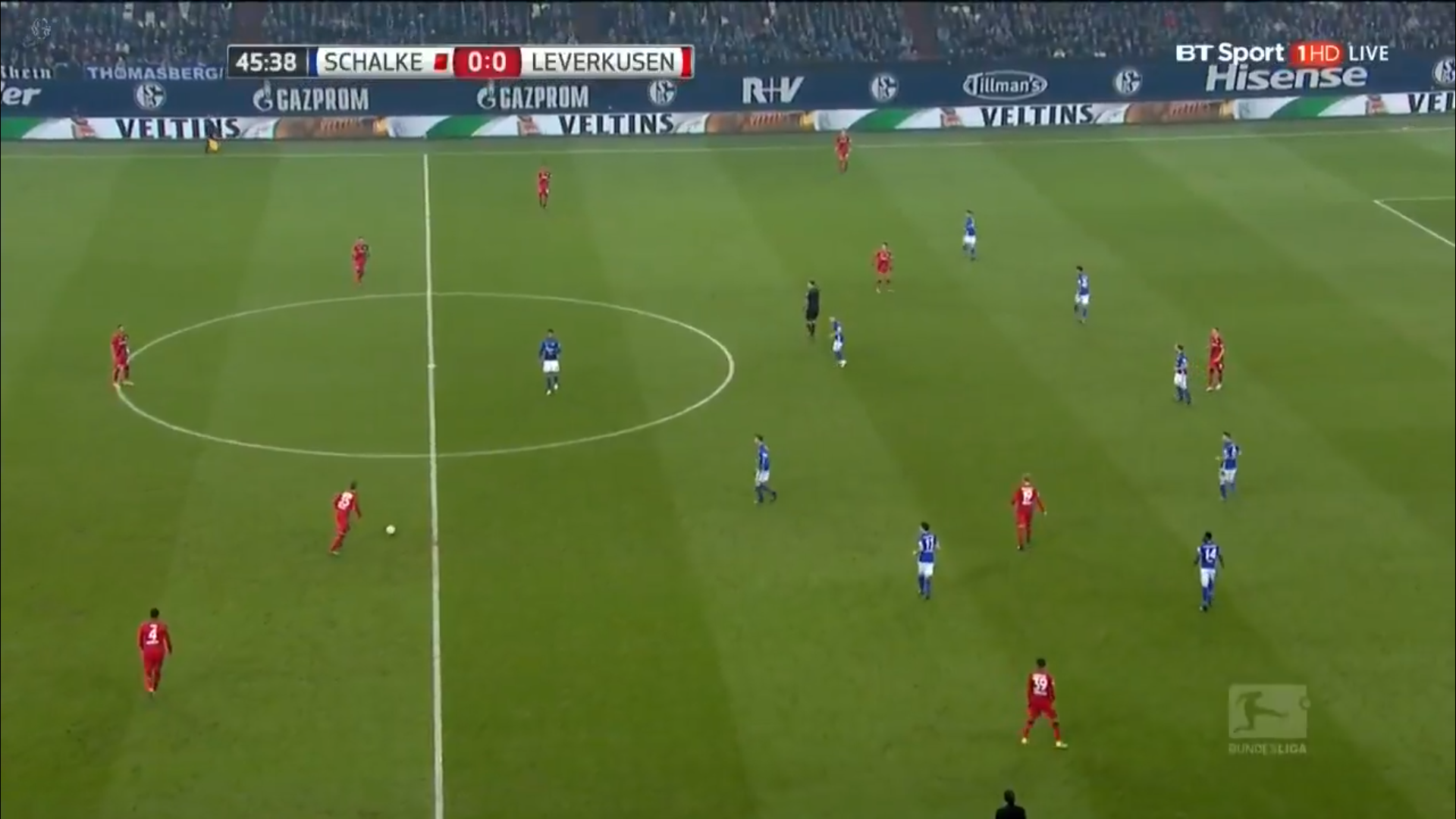
Goretzka and Meyer made important interceptions and their sound positoning in central midfield reduced the service to the Leverkusen strikers, who would have both preferred better service to their feet, especially since the away side weren’t delivering many crosses into the box. The goal conceded on the set piece at the end of the game could be put down to a lack of marking as Kiessling was afforded plenty of space and time to execute his header.
Schalke in transition
It took Schalke about eighteen minutes for them to spring their first counter attack of the game. This could probably be attributed to their need to settle into the game after going a man down after less than five minutes. The two key players in Schalke’s transition were Baba Rahman and Yevhen Konoplyanka on the left and right wing respectively. While the Ukrianian lacked the Ghanian’s pace, he made up for it by being technically sound enough to keep the ball long enough for late runs from Schalke’s midfielders to penetrate the Leverkusen defence.
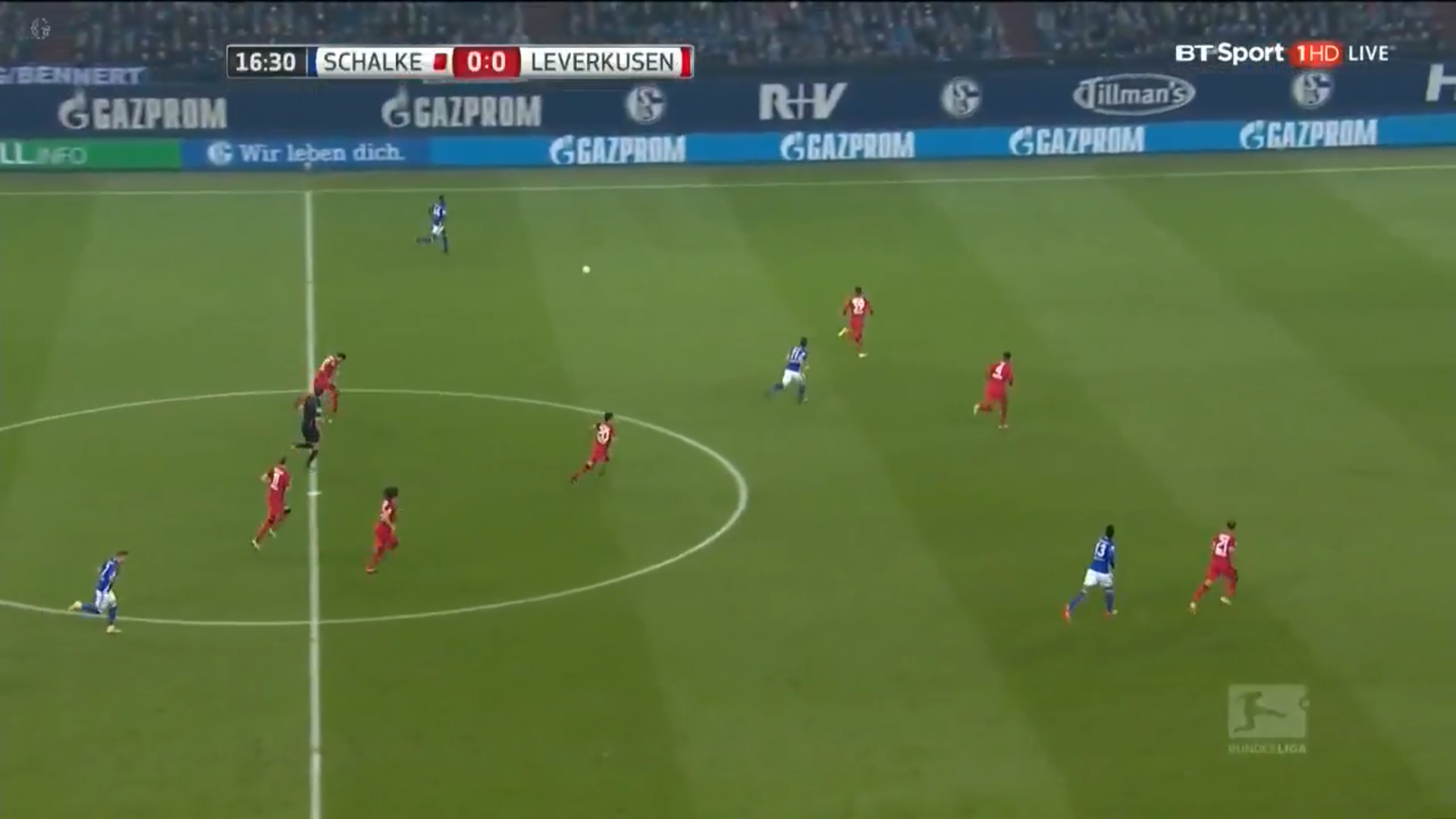
For all Leverkusen’s possession, as the game progressed, they became sloppy in the moments they gave the ball away and were not sharp enough to recover possession. This combined with Schalke’s growing energy and speed of transition was enough to give Schalke the better chances of the game. Baba Rahman’s pace made him a handful on the left wing and allowed Schalke to take the ball far away from Leverkusen’s half and provide some respite. Choupo-Moting’s runs through the middle provided the final link in the home side’s counter attack and they can certainly take some positives from these passages of play.
Conclusion
Overall, the early sending off certainly changed the game or we might have seen a different Schalke side grow into the game, despite their slower start. Both sides are close to the middle of the table and will have plenty to work on to fight their way into the upper half of the table.
Read all our tactical analyses here.
- Tactical Analysis: Schalke 0-1 Leverkusen | Sending off ruins Schalke plans - December 19, 2016
- Tactical Analysis: Dortmund 4-1 Mönchengladbach |Dortmund’s patience and clinical finishing - December 8, 2016
- Tactical Analysis: Wolfsburg 1-5 Borussia Dortmund | Tuchel’s men win emphatically - September 24, 2016




















































